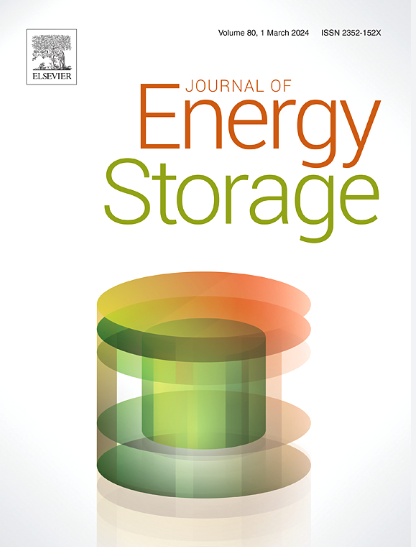通过在电解质中引入阴离子受体添加剂,提高锂离子电池的长期稳定性和耐高温性能
IF 8.9
2区 工程技术
Q1 ENERGY & FUELS
引用次数: 0
摘要
层状三元氧化物LiNixMnyCo1-x-yO2是一种很有前途的高能锂离子电池(LIBs)阴极候选者。然而,电解质与电极之间严重的副反应限制了其在高温下的发展。为了提高LiNi0.6Mn0.2Co0.2O2 (NCM622)基锂离子电池的长期稳定性和耐高温性能,在二氟硼酸锂(LiODFB)基电解质中引入阴离子受体添加剂三(五氟苯基)硼烷(TPFPB)。拉曼光谱和表面分析表明,由于TPFPB与ODFB -之间的强相互作用,ODFB -在Li+溶剂化结构中的比例增加,导致NCM622表面更多的ODFB -富集。此外,具有较高已占分子轨道能级的TPFPB和ODFB−可以优先分解,形成坚固的富无机且热稳定性好的CEI层,从而减轻溶剂分解,从而减少不可逆锂的损失。结果表明,含TPFPB电解质的NCM622||锂电池具有良好的长期稳定性,在55°C下0.5C倍率下100次循环后的容量保持率为83.89%,远高于未添加TPFPB的电池的52.61%。本研究提供了一种通过在电解质中引入阴离子受体添加剂来促进锂离子电池长期稳定性和高温耐受性的策略,这对高性能锂离子电池的开发具有重要意义。本文章由计算机程序翻译,如有差异,请以英文原文为准。
Promoting long-term stability and high-temperature tolerance of lithium-ion batteries by introducing anion receptor additives into electrolyte
Layered ternary oxides LiNixMnyCo1-x-yO2 is a promising cathode candidates for high-energy lithium-ion batteries (LIBs). However, severe side reaction between electrolyte and electrode limits its development at high temperature. Herein, an anion receptor additive tris(pentafluorophenyl)borane (TPFPB) is introduced in lithium difluoro(oxalato)borate (LiODFB)-based electrolyte to improve the long-term stability and high-temperature tolerance of LiNi0.6Mn0.2Co0.2O2 (NCM622)-based LIBs. Raman spectra and surface analysis show that the proportion of ODFB− in Li+ solvated structure is strengthened due to the strong interaction between TPFPB and ODFB−, which leads to more ODFB− enriching on the surface of NCM622. Moreover, TPFPB and ODFB− with higher occupied molecular orbital energy level can be preferentially decomposed to form a robust inorganic-rich and well thermal stability CEI layer, which can alleviate solvents decomposition and thus reduce the loss of irreversible lithium. As a result, NCM622||Li battery with the TPFPB-containing electrolyte delivers good long-term stability with a capacity retention of 83.89 % after 100 cycles at the rate of 0.5C under 55 °C, much higher than 52.61 % of the one without TPFPB additives. This work provides a strategy to promote the long-term stability and high-temperature tolerance of LIBs by introducing anion receptor additives into the electrolyte, which has important implications for the development of high-performance LIBs.
求助全文
通过发布文献求助,成功后即可免费获取论文全文。
去求助
来源期刊

Journal of energy storage
Energy-Renewable Energy, Sustainability and the Environment
CiteScore
11.80
自引率
24.50%
发文量
2262
审稿时长
69 days
期刊介绍:
Journal of energy storage focusses on all aspects of energy storage, in particular systems integration, electric grid integration, modelling and analysis, novel energy storage technologies, sizing and management strategies, business models for operation of storage systems and energy storage developments worldwide.
 求助内容:
求助内容: 应助结果提醒方式:
应助结果提醒方式:


